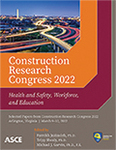Lean-Based Integrated Approach for Manual Work Design Optimization in Modular Construction
Publication: Construction Research Congress 2022
ABSTRACT
Well-designed manual work operations are critical to enhancing the productivity and safety of modular construction production lines. Thus, it is essential to analyze current work procedures, and then design the safest and most efficient work methods accordingly. However, what is lacking is an approach for identifying optimal work methods based on consideration, simultaneously, of several design criteria, such as workplace configurations, task time, and ergonomic risk. Furthermore, existing perception-based methods are not conducive to a careful examination of the trade-off between safety and efficiency for different work scenarios. To overcome these limitations, this paper proposes an integrated approach to manual work design optimization in modular construction. This is accomplished by coupling Lean manufacturing tools and statistical analysis of the design of experiments (DOE) with 3D-based ergonomic posture assessment and Predetermined Motion Time Systems (PMTS). As a case study, a drywall sanding task in a modular construction production line is designed. The results indicate the effectiveness of the proposed method to investigate multiple scenarios and thereby achieve optimum design.
Get full access to this article
View all available purchase options and get full access to this chapter.
REFERENCES
Deb, K., Pratap, A., Agarwal, S., and Meyarivan, T. (2002). “A fast and elitist multiobjective genetic algorithm: NSGA-II.” IEEE Transactions on Evolutionary Computation, 6(2), 182–197.
Freivalds, A., and Niebel, B. (2013). Niebel’s Methods, Standards, & Work Design. McGraw-Hill, New York.
Golabchi, A., Han, S., and AbouRizk, S. (2018). “A simulation and visualization-based framework of labor efficiency and safety analysis for prevention through design and planning.” Automation in Construction, 96, 310–323.
Golabchi, A., Han, S., and Fayek, A. R. (2016a). “A fuzzy logic approach to posture-based ergonomic analysis for field observation and assessment of construction manual operations.” Canadian Journal of Civil Engineering, 43(4), 294–303.
Golabchi, A., Han, S., Seo, J., Han, S., Lee, S., and Al-Hussein, M. (2015). “An Automated biomechanical simulation approach to ergonomic job analysis for workplace design.” Journal of Construction Engineering and Management, 141(8), 04015020.
Golabchi, A., Han, S. U., AbouRizk, S., and Kanerva, J. (2016b). “Micro-motion level simulation for efficiency analysis and duration estimation of manual operations.” Automation in Construction, 71(Part 2), 443–452.
Laura, H. I. L., Isabelina, N., and Joel, J. (2011). “Use of safety and lean integrated kaizen to improve performance in modular homebuilding.” Journal of Construction Engineering and Management, 137(7), 551–560.
Hignett, S., and McAtamney, L. (2000). “Rapid Entire Body Assessment (REBA).” Applied Ergonomics, 31(2), 201–205.
Jones, B., and Nachtsheim, C. J. (2011). “A class of three-level designs for definitive screening in the presence of second-order effects.” Journal of Quality Technology, 43(1), 1–15.
Li, X., Han, S., Gül, M., and Al-Hussein, M. (2019). “Automated post-3D visualization ergonomic analysis system for rapid workplace design in modular construction.” Automation in Construction, 98, 160–174.
Li, X., Han, S., Gül, M., Al-Hussein, M., and El-Rich, M. (2018). “3D visualization-based ergonomic risk assessment and work modification framework and its validation for a lifting task.” Journal of Construction Engineering and Management, 144(1), 04017093.
Maynard, H. B., Stegemerten, G. J., and Schwab, J. L. (1948). Methods-time measurement. McGraw-Hill, New York.
Rother, M., and Harris, R. (2001). Creating continuous flow: An action guide for managers, engineers & production associates. Lean Enterprise Institute.
Sivaloganathan, S., and Yanis, R. (2015). Design for method study—work measurement: Do we need it? BT - ICoRD’15 – Research into Design Across Boundaries Volume 2. A. Chakrabarti, ed., Springer India, New Delhi, 313–326.
Zaalouk, A., and Han, S. (2021a). “An interactive simulation approach for an ergonomic-driven workplace design in off-site construction facilities.” Proceedings, Construction Research Congress 2020.
Zaalouk, A., and Han, S. (2021b). “Parameterized design optimization framework for worker-friendly workplaces in modular construction.” Journal of Construction Engineering and Management, 147(5), 4021030.
Information & Authors
Information
Published In
History
Published online: Mar 7, 2022
Authors
Metrics & Citations
Metrics
Citations
Download citation
If you have the appropriate software installed, you can download article citation data to the citation manager of your choice. Simply select your manager software from the list below and click Download.
